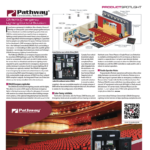
Pathway’s Pathport DMX-over-Ethernet Gateways are Still an Industry Standard
Pathway Connectivity Solutions’ Pathport DMX-over-Ethernet gateways have long been the impressively dependable backbone to lighting systems around the world. How impressive? If you could choose only one phrase for each model in their line of devices, this writer would choose “fiercely dependable.” They have made — and continue to make — thousands of productions and installations possible.
Pathway’s Robert Bell testifies to the reliability of the company’s products. “I was working as a television lighting director, often for the Canadian Broadcasting Corporation, when Pathport was released 20 years ago,” he notes. “I’ve now been heading R&D at Pathway for 10 years and proud to report that the Pathport is still the gateway of choice for the CBC. They were an early adopter and still a very valuable customer.”
Over the years, Pathway has continued to provide development and products solving the challenges of major scale production data distribution and data security. And the company’s offerings have changed as production needs have evolved. Long gone, for example, are the days where 2048 DMX channels was a large show. Several hundred universes are the norm now on exceptionally large shows, with a solid average of eight to 12 universes of lighting being the repeatable average on smaller shows.
Product Overview
Here’s a quick overview of the current Pathport line, from the greatest number of outputs to the least. First up is OCTO, the eight-port, front panel accessible heavyweight, configurable to have any port connector type you want (XLRF, XLRM, terminal, or RJ45). QUATTRO is the four-port hard hitter with the same option; you choose your connector. One and two port units include the C-Series, a two-port wall mount; UNO, a one-port wall mounted gateway; and its sister product, Portable UNO. The Touring Edition is a one-port gateway configured as a truss mount with a front interface and stand-alone RDM controller. Pathport also offers DIN-mountable models in one-, two- and four-port models.
Pathport products cover all applicable scenarios for sending DMX data over Ethernet, and they can be configured on-site without having to drag out a laptop to change settings on a gateway. All of the major lighting communication protocols are covered — streaming ACN (E 1.31), Art-Net, Pathport’s proprietary protocol, ShowNet and ETC Net2. In addition, all of these devices (with the exception of the OCTO) can be powered over Ethernet (PoE) to remove the need for a dedicated power point where the gateway needs to live. Using the free Pathscape software, your Pathport device can also function as a E1.20 RDM proxy controller. DMX speed, and how the unit behaves during a signal loss event, are also options for your choosing.
A special consideration has been made by Pathway to fight back against hackers around the world, adding integrity to your lighting network and blocking those who might try to exploit network access to wage ransomware attacks on your data or run distributed denial of service (DDOS) attacks on your network. Pathport devices are shipped with updated firmware that integrates with the security features of Pathscape, Pathway’s free software solution for VIA, Pathport gateways, Pathway Connectivity eLink, Cognito2, Choreo, NSB, Vignette, and eDIN interface cards (using RDM). Pathway seems to understand that the days of not worrying about someone hacking the lighting network are over.
Each port on every Pathport gateway is individually configurable, allowing users to configure the gateway however the application is best suited. They can arrange to have all ports be their own universe, or maybe set up two ports on one universe and one for another, and so on. You can also route your DMX on a universe, or on a channel-by-channel basis — and you can map multiple sources to each individual output channel, with user-configurable merge and/or priority options. Pathway strives to provide user control to all their products. A case in point: the OCTO, QUATTRO, and Touring Edition gateways all have a front panel interfaces that let users set and edit control settings right from the device. That feature set is particularly well suited for our industry, where a span of just 15 seconds can be critically important. Major kudos to Pathway for that feature.
This writer’s opinion is that the Pathport product line (and the VIA product line) are two major artery types that keep our signals working properly. It’s highly recommended that you check out these lines, call the company and get a demo.
For more information, please visit pathwayconnect.com


